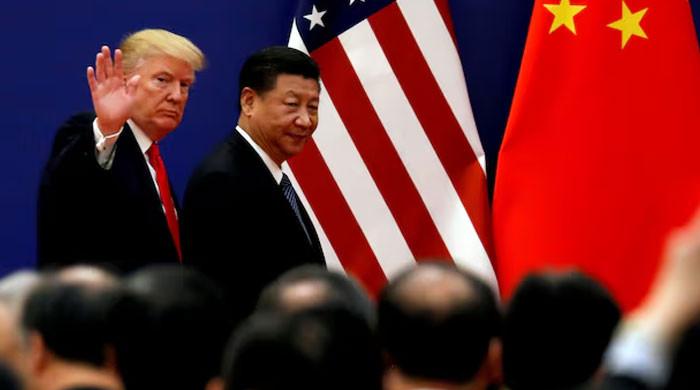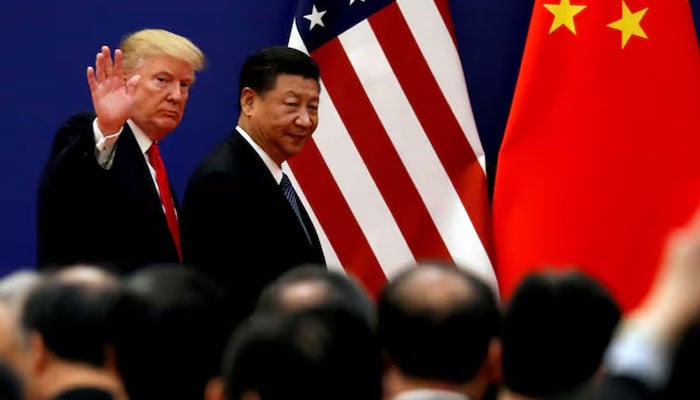China-US trade tensions under Trump 2.0


The United States has imposed an additional 10% tariff on China as President Donald Trump followed through on his promise to wield Washington’s vast economic weight to hit back at Beijing for its alleged unfair trade practices and role in the country’s deadly fentanyl crisis.
Reacting to the development, China said that it firmly opposed the move and would take “corresponding countermeasures to resolutely safeguard” its interests.
With the two countries seemingly looking down at a possible trade war, here’s an overview of the trade relationship between the two economic giants.
Trade at risk
Trade between China and the United States — the world’s two largest economies — is vast, totalling more than $530 billion in the first 11 months of 2024, according to Washington.
Over that same period, sales of Chinese goods to the US totalled more than $400 billion, second only to Mexico.
According to the Peterson Institute of International Economics (PIIE), China is the dominant supplier of goods from electronics and electrical machinery to textiles and clothing.
But a yawning trade imbalance, which amounted to $270.4 billion from January to November last year, has long raised hackles in Washington.
But China’s economy remains heavily reliant on exports to drive growth despite official efforts to raise domestic consumption —making its leaders reluctant to change the status quo.
First Trump administration
President Trump stormed into the White House in 2016 vowing to get even with China, launching a trade war that slapped significant tariffs on hundreds of billions of dollars of Chinese goods.
China responded with retaliatory tariffs on US products —particularly affecting American farmers.
Key US demands were greater access to China’s markets, broad reform of a business playing field.
After long, fraught negotiations the two sides agreed on what became known as the “phase one” trade deal — a ceasefire in the nearly two-year-old trade war.
Under that agreement, Beijing agreed to import $200 billion worth of US goods, including $32 billion in farm products and seafood.
But in the face of the COVID-19 pandemic and a US recession, analysts say Beijing fell well short of that commitment.
“In the end, China bought only 58% of the US exports it had committed to purchase under the agreement, not even enough to reach its import levels from before the trade war,” PIIE’S Chad P Brown wrote.
“Put differently, China bought none of the additional $200 billion of exports Trump’s deal had promised.”
Biden govt
Trump’s successor Joe Biden did not roll back increases imposed by his predecessor but took a more targeted approach when it came to tariff hikes.
Under Biden, Washington expanded efforts to curb exports of state-of-the-art chips to China.
His administration also used tariffs to take aim at what it called China’s “industrial overcapacity” — fears the country’s industrial subsidies for green energy, cars and batteries could flood global markets with cheap goods.
Last May, Biden ordered tariffs on $18 billion worth of imports from China.
Under the hikes, tariffs on electric vehicles quadrupled to 100%, while the tariff for semiconductors surged from 25% to 50%.
The measures also targeted strategic sectors such as batteries, critical minerals and medical products.
Both sides have also launched investigations into the others’ alleged unfair trade practices with probes into dumping and state subsidies.
What happens now?
Sunday’s announcement reflects President Trump’s long-threatened tariff hikes were serious and not an opening gambit in negotiations.
The mercurial magnate has also tied tariffs to the fate of the Chinese-owned social media app TikTok — warning of retaliation if a deal cannot be struck to sell it.
But Beijing’s strong riposte has left little doubt that it will push back against measures it has long viewed as unfair.
The Chinese commerce ministry has vowed “corresponding countermeasures to resolutely safeguard our own rights and interests”, without saying what form they will take.
It has also said it will take its case against Trump’s tariffs to the World Trade Organisation (WTO), though that is unlikely to bring change in the short term.
More immediate is the threat by Beijing’s foreign ministry that the duties “will inevitably affect and damage future bilateral cooperation on drug control”.
That casts a new shadow over counter-narcotics talks that resumed after Biden met Chinese President Xi Jinping in San Francisco in 2023.
A US-China working group later said it would step up regulation of three key fentanyl precursors, though it is not clear how much success has been achieved.



